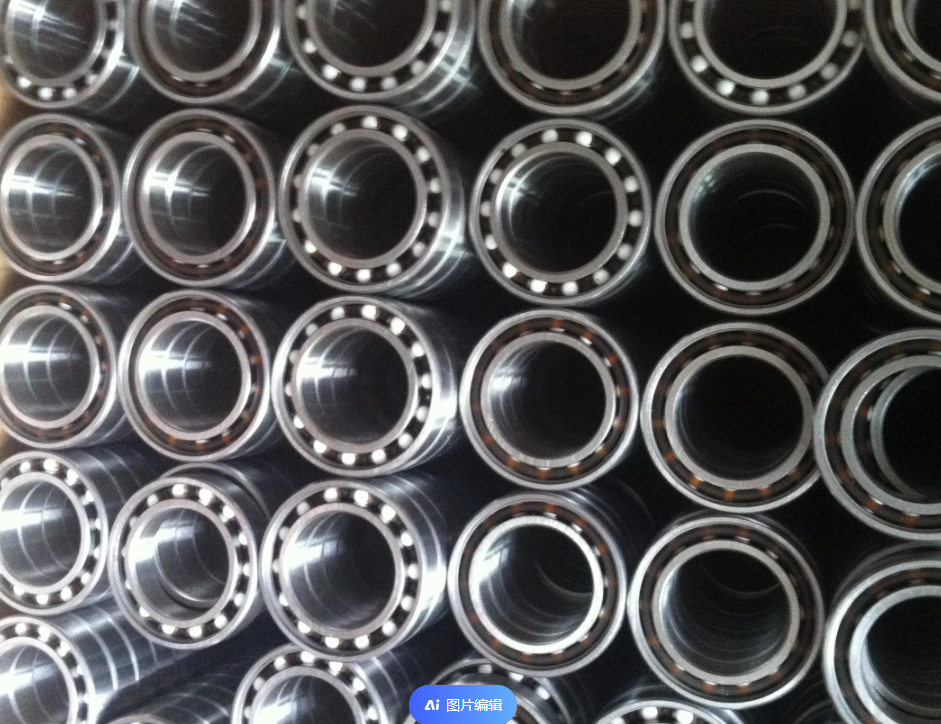1. Bearing in electrical damage (groove)
Continuous passage of AC or DC current, even at low currents, can cause electrical damage.

Bearing phenomena
Brown marks parallel to the shaft may be observed on a large part of the raceway or covering the entire circumference of the raceway.
Bearing measures
Prevent current flow through the bearings by grounding or using insulated bearings.
2. Bearing fatigue (spalling)
Spalling is usually caused by overloading, excessive preload, tight inner ring fits and use of the bearing beyond the calculated fatigue life.
Bearing phenomena
Fatigue can be indicated by fracture of the running surfaces and subsequent removal of small, discrete particles of material from the inner ring, outer ring or rolling elements. Spalling is gradual and spreads with continued operation. It is always accompanied by a significant increase in vibration and noise.
Bearing Measures
Replace the bearing and/or consider a redesign with a bearing that has a longer calculated fatigue life, internal clearance, and proper shaft and housing recommendations.
Bearing Phenomena
Fatigue can be indicated by fracture of the running surfaces and subsequent removal of small, discrete particles of material from the inner ring, outer ring or rolling elements. Spalling is gradual and spreads with continued operation. It is always accompanied by a significant increase in vibration and noise.
3. Overheating during bearing operation
Overheating is usually caused by high operating temperatures and improper lubrication. High temperatures cause grease to seep out (oil removal), which reduces the efficiency of the lubricant. At high temperatures, oxidation can cause the loss of lubricant from the grease, leaving a dry, crusty soap that can seize the bearing. Higher temperatures can also reduce the hardness of the metal, leading to early failure.
Bearing phenomena
Note any discolouration of rings, rolling elements and cages. In extreme cases, bearing components can deform. Higher temperatures can also degrade or destroy the lubricant.
Bearing measures
Thermal or overload control, adequate heat paths and supplemental cooling are the best options for relieving overheating.
4. Excessive loads on bearings
Excessive loads applied to bearings are another common cause of failure.
Bearing Phenomena
Undulating rolling element wear paths, signs of overheating and extensive fatigue areas may be seen.
Bearing Measures
Reduce the load or consider a redesign with a higher capacity bearing.
5. Improper storage and handling of bearings
Improper storage can expose bearings to moisture and dust. Storing bearings at excessive temperatures can also reduce the shelf life of the grease, so always consult the grease manufacturer for storage specifications. Handling bearings by opening the box and tearing the package prematurely can allow dust to enter and expose the bearings to corrosive elements.
Bearing phenomena
Be aware of humidity and temperatures that may cause rust and/or bearing exposure in storage areas.
Bearing Measures
Store bearings in a dry area at room temperature. Always cover the bearings during storage to keep them clean and take them to the installation site before unpacking.
6. Bearing fit fit
Excessive loading of rolling elements may result in a tight fit when the interference fit exceeds the radial clearance at operating temperature. Fitting relative to the action force is too loose between the mating parts of the micro-movement may lead to fit loosening.
Bearing phenomena
For tight fits, look for severe wear paths of the rolling elements at the bottom of the raceway, overheating, or axial cracks in the inner ring. For loose styles, look for any micro-movement (the creation of fine metal particles), which will leave a distinctive brown colour. Wear on mating surfaces can lead to noise and runout problems.
Bearing measures
Ensure proper clearance is selected to avoid fit problems. Refer to the manufacturer’s installation guide.
II. Significance of Preventing Bearing Failure
By understanding the different issues that can lead to bearing failure and the signs to look for, you’ve taken a big step toward limiting machine failure. Of course, you don’t have to wait for the symptoms of bearing failure to take action. Regular preventative measures can keep your bearings performing at their best for as long as possible, saving your business time and money!
Translated with www.DeepL.com/Translator (free version)
Post time: Jun-13-2025